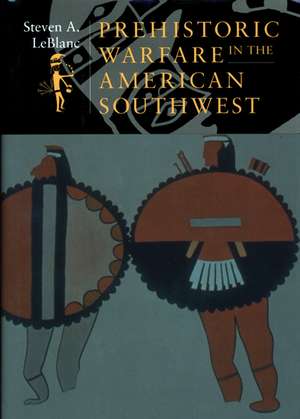Prehistoric Warfare in the American Southwest
Autor Steven A LeBlancen Limba Engleză Paperback – 29 apr 2007 – vârsta până la 80 ani
Massacres, raiding parties, ambush, pillage, scalping, captive taking: the things we know and sometimes dread to admit occur during times of war all happened in the prehistoric Southwest—and there is ample archaeological evidence. Not only did it occur, but the history of the ancient Southwest cannot be understood without noting the intensity and impact of this warfare.
Most people today, including many archaeologists, view the Pueblo people of the Southwest as historically peaceful, sedentary corn farmers. Our image of the Hopis and Zunis, for example, contrasts sharply with the more nomadic Apaches whose warfare and raiding abilities are legendary. In Prehistoric Warfare in the American Southwest Steven LeBlanc demonstrates that this picture of the ancient Puebloans is highly romanticized. Taking a pan-Southwestern view of the entire prehistoric and early historic time range and considering archaeological and ethnohistorical evidence and oral traditions, he presents a different picture.
War, not peace, was commonplace and deadly throughout the prehistoric sequence. Many sites were built as fortresses, communities were destroyed, and populations massacred. The well-known abandonments of much of the Southwest were warfare related. During the late prehistoric period fighting was particularly intense, and the structure of the historic pueblo societies was heavily influenced by warfare.
Objectively sought, evidence for war and its consequences is abundant. The people of the region fought for their survival and evolved their societies to meet the demands of conflict. Ultimately, LeBlanc asserts that the warfare can be understood in terms of climate change, population growth, and their consequences.
Most people today, including many archaeologists, view the Pueblo people of the Southwest as historically peaceful, sedentary corn farmers. Our image of the Hopis and Zunis, for example, contrasts sharply with the more nomadic Apaches whose warfare and raiding abilities are legendary. In Prehistoric Warfare in the American Southwest Steven LeBlanc demonstrates that this picture of the ancient Puebloans is highly romanticized. Taking a pan-Southwestern view of the entire prehistoric and early historic time range and considering archaeological and ethnohistorical evidence and oral traditions, he presents a different picture.
War, not peace, was commonplace and deadly throughout the prehistoric sequence. Many sites were built as fortresses, communities were destroyed, and populations massacred. The well-known abandonments of much of the Southwest were warfare related. During the late prehistoric period fighting was particularly intense, and the structure of the historic pueblo societies was heavily influenced by warfare.
Objectively sought, evidence for war and its consequences is abundant. The people of the region fought for their survival and evolved their societies to meet the demands of conflict. Ultimately, LeBlanc asserts that the warfare can be understood in terms of climate change, population growth, and their consequences.
Preț: 237.03 lei
Preț vechi: 293.03 lei
-19% Nou
Puncte Express: 356
Preț estimativ în valută:
45.36€ • 47.71$ • 37.90£
45.36€ • 47.71$ • 37.90£
Carte indisponibilă temporar
Doresc să fiu notificat când acest titlu va fi disponibil:
Se trimite...
Preluare comenzi: 021 569.72.76
Specificații
ISBN-13: 9780874809084
ISBN-10: 0874809088
Pagini: 416
Ilustrații: 70 figures, 6 tables
Dimensiuni: 178 x 254 x 33 mm
Greutate: 0.8 kg
Ediția:1st Edition
Editura: University of Utah Press
Colecția University of Utah Press
ISBN-10: 0874809088
Pagini: 416
Ilustrații: 70 figures, 6 tables
Dimensiuni: 178 x 254 x 33 mm
Greutate: 0.8 kg
Ediția:1st Edition
Editura: University of Utah Press
Colecția University of Utah Press
Recenzii
"Will be required reading for everyone concerned with the precontact Southwest or with the pre-Industrial Age human condition."—Patty Jo Watson
"This book should stimulate a long-overdue debate about the role of warfare in the prehistoric Southwest….Nothing half as comprehensive has been published on the subject."—Richard Woodbury
"Absolutely essential on the bookshelf of any scholar of the prehistoric or historic Southwest. It promises to spark and focus debate on the formation of basic patterns in the culture history of the greater Southwest."—The Journal of Arizona History
"Will put to rest any reasonable doubts that may persist about the presence and importance of warfare in the archaeological history of this region. [Le Blanc] has taken the analysis of warfare in the Southwest to an entirely new level."—Journal of Field Archaeology
"Successfully articulates why warfare needs to be systematically incorporated into models of prehistoric southwestern behavior. LeBlanc clearly presents a case for wafare that all scholars must address."—New Mexico Book Reviews
"There has been a wave of books by various authors that challenge the long-standing suppositions of anthropologists and archaeologists. One of these for Western history is Steven A. LeBlanc's groundbreaking work on the not-to-be-overlooked evidence all over the Southwest of continuous warfare for limited resources."—Journal of the West
"Unique for its general synthesis of Southwestern prehistory. LeBlanc's book has much to offer scholars and the interested public, and it will certainly be a defining work on warfare in this part of the world."—Science
"This is not a book for the faint of heart. But, in building his case for both endemic warfare and specific periods of lessened and heightened polity-based hostilities in the Southwest, LeBlanc raises a host of critical and deeply interesting questions regarding the nature of warfare in prehistorical societies in general and the Southwest in particular."—American Antiquity
Notă biografică
Steven A. LeBlanc is a research associate of the Institute of Archaeology, University of California, Los Angelas.
Descriere
Contests the highly romanticized picture of the ancient Puebloans as peaceful, sedentary corn farmers and suggests that people of the region fought for their survival.
